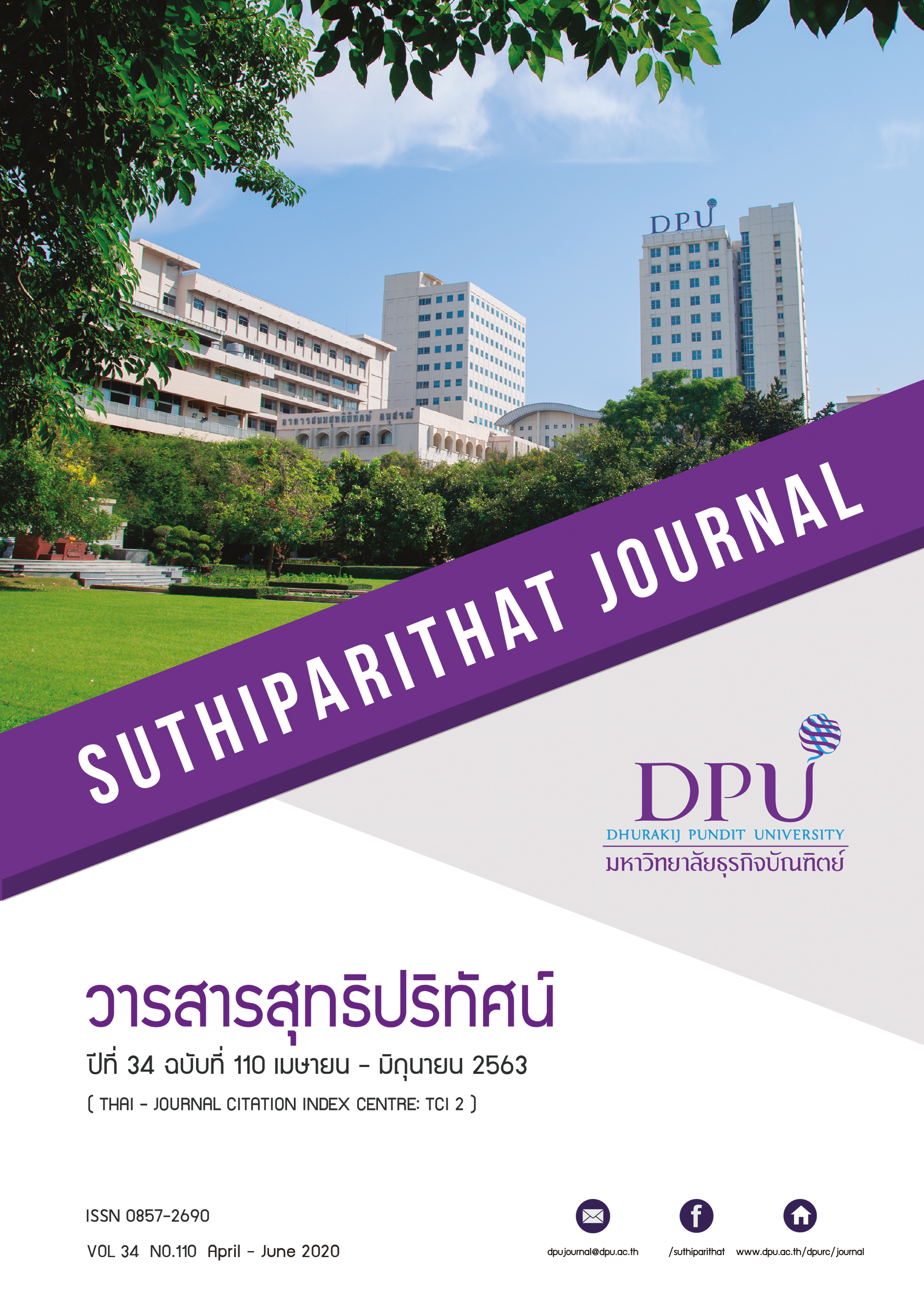ปัจจัยที่มีผลต่อความภักดีในการซื้อสินค้าและบริการผ่านออนไลน์ของคนเจเนอเรชั่นเอ็กซ์
คำสำคัญ:
การยอมรับเทคโนโลยี, นวัตกรรมบริการ, ความภักดีในการซื้อสินค้าผ่านออนไลน์, เจเนอเรชั่นเอ็กซ์บทคัดย่อ
การศึกษาวิจัยครั้งนี้มีวัตถุประสงค์เพื่อศึกษาระดับความคิดเห็นเกี่ยวกับการยอบรับเทคโนโลยี นวัตกรรมบริการ ความภักดีในการซื้อสินค้าและบริการผ่านออนไลน์ของคนเจเนอเรชั่นเอ็กซ์ และศึกษาปัจจัยที่มีผลต่อความภักดีในการซื้อสินค้าและบริการผ่านออนไลน์ของคนเจเนอเรชั่นเอ็กซ์ เก็บรวมรวมข้อมูลจากกลุ่มคนเจเนอเรชั่นเอ็กซ์ที่พักอาศัยอยู่ในเขตกรุงเทพมหานครจำนวน 400 คน สถิติที่ใช้ในการวิเคราะห์ ได้แก่ ค่าเฉลี่ย ส่วนเบี่ยงเบนมาตรฐาน และสถิติที่ใช้ในการทดสอบสมมติฐานใช้การวิเคราะห์แบบการถดถอยเชิงพหุคูณ ผลการวิจัยพบว่าความคิดเห็นของผู้ตอบแบบสอบถามเกี่ยวกับการยอมรับเทคโนโลยี นวัตกรรมบริการ และความภักดีในการซื้อสินค้าและบริการผ่านออนไลน์อยู่ในระดับดี และผลการทดสอบสมมติฐานพบว่า การรับรู้ความง่าย การรับรู้ประโยชน์ การรับรู้ความเสี่ยง ทัศนคติต่อการใช้งาน การนำเทคโนโลยีใหม่มาใช้ในการบริการและการมีปฏิสัมพันธ์กับลูกค้ามีอิทธิพลต่อความภักดีในการซื้อสินค้าและบริการผ่านออนไลน์ของคนเจเนอเรชั่นเอ็กซ์
เอกสารอ้างอิง
กัลยา วานิชย์บัญชา. (2549). สถิติสำหรับงานวิจัย (พิมพ์ครั้งที่ 2). กรุงเทพฯ: โรงพิมพ์แห่งจุฬาลงกรณ์มหาวิทยาลัย.
ชัชพล ทรงสุนทรวงศ์. (2559). นวัตกรรมการบริการ : กลยุทธ์ที่สร้างความได้เปรียบทางการแข่งขันขององค์การธุรกิจบริการ. วารสารการจัดการสมัยใหม่, 14(2), 13-24.
ณัฐสพันธ์ เผ่าพันธุ์. (2552). ทัศนคติของผู้ใช้อินเทอร์เน็ตที่มีต่อความตั้งใจซื้อสินค้าผ่านออนไลน์. การประชุมวิชาการระดับชาติ มหาวิทยาลัยศรีปทุม ปีการศึกษา 2552 (14 สิงหาคม 2552). กรุงเทพฯ: มหาวิทยาลัยศรีปทุม.
ธีรนันท์ ศรีหงส์. (2557). Digital banking อนาคตของโลกการเงินในวันนี้. สืบค้น 25 สิงหาคม 2562, จาก Forbesthailand.com/news/other/digital-banking-อนาคตของโลกการเงินใน.html.
มัสลิน ใจคุณ. (2561). การยอมรับเทคโนโลยี ความไว้วางใจและการตลาดผ่านสังคมออนไลน์ที่มีผลต่อความตั้งใจซื้อสินค้าผ่านช่องทางเฟซบุ๊ก ไลฟ์ (Facebook LIVE) ของกลุ่มผู้บริโภค Generations X, Y, Z (วิทยานิพนธ์ปริญญามหาบัณฑิต). กรุงเทพฯ: มหาวิทยาลัยเทคโนโลยีราชมงคลกรุงเทพ.
วิลาสินี อินทร์สุวรรณ. (2561). การบริหารงานลูกค้าสัมพันธ์บนสื่อสังคมออนไลน์ของบริษัทแอลจีอิเล็กทรอนิกส์(ประเทศไทย) จำกัด และความภักดีต่อตราสินค้าในเขตกรุงเทพ (สารนิพนธ์ปริญญามหาบัณฑิต). กรุงเทพฯ: มหาวิทยาลัยกรุงเทพ.
ศิริชัย กาญจนวาสี, ทวีวัฒน์ ปิตยานนท์, และดิเรก ศรีสุโข. (2551). การเลือกใช้สถิติที่เหมาะสมสำหรับการวิจัย (พิมพ์ครั้งที่ 5) กรุงเทพฯ: โรงพิมพ์แห่งจุฬาลงกรณ์มหาวิทยาลัย.
สำนักงานพัฒนาธุรกรรมทางอิเล็กทรอนิกส์. (2562). ETDA เผยมูลค่า e-Commerce ไทยโตต่อเนื่อง ยอดปี 2561 พุ่งสูง 3.2 ล้านล้านบาท. สืบค้น 30 สิงหาคม 2562, จาก https://www.etda.or.th/content/etda-เผย-อีคอมเมิร์ซ-ไทย-โตต่อเนื่อง-2561-3-2-ล้านล้านบาท.html
สำนักงานสถิติแห่งชาติ. (2561). จำนวนประชากรจากการทะเบียน จำแนกตามกลุ่มอายุรายจังหวัดและภาค พ.ศ. 2552-2561. สืบค้น 2 กันยายน 2562, จาก http://statbbi.nso.go.th/staticreport/page/sector/th/01.aspx
Acar, AB. (2014). Do intrinsic and extrinsic motivation factors differ for generation X and generation Y?. International Journal of Business and Social Science, 5(5), 12-20.
Barcet, A. (2010). Innovation in services: a new paradigm and innovation model, Handbook of innovation and services: A Multi-disciplinary Perspective, (49-67). Cheltenham: Edward Elgar.
Brown, K., Ryan, N., & Parker, R. (2000). New modes of service delivery in the public sector: Commercialising government services. International Journal of Public Sector Management, 13(3), 206-221.
Busch, P., Venkitachalam, K., & Richards, D. (2008). Generational differences in soft knowledge situations: Status, need for recognition, workplace commitment and idealism. Knowledge and Process Management, 15(1), 45–58.
Davis, F.D. (1989). Perceived usefulness, perceived ease of use and user acceptance of information technology. MIS Quarterly, 13, 319-340.
Davis, F. D., Bagozzi, R., & Warshaw, P. (1989). User acceptance of computer technology A comparision of two theoretical models. Management Science, 35(8), 982-1003.
Dowling, G. R. (1986). Perceived risk: The concept and its measurement. Psychology and Marketing, 3(3), 193-210.
Eid, M. I. (2011). Determinants of E-commerce customer satisfaction, trust, and loyalty in Saudi Arabia. Journal of Electronic Commerce Research, 12(1), 78-93.
European Commission. (2014). The smart guide to service innovation. Retrieved July 30, 2019, from http://ec.europa.eu/DocsRoom/documents/3955/attachments/1/translations/en/renditions/pdf
Fishbein, M., & Ajzen, I. (1975). Belief, attitude, intentions and behavior: An introduction to theory and research. Reading, MA: Addison-Wesley.
Giannopoulou, E., Gryszkiewicz, L., & Barlatier, P. (2014). Creativity for service innovation: a practice-based perspective. Journal of Service Theory and Practice, 24(1), 23-44.
Ha, S., & Stoel, L. (2009). Consumer E-shopping acceptance: Antecedents in a technology acceptance model. Journal of Business Research, 62(5), 565-571.
Hitesh, B. (2019). Brand loyalty and its importance. Retrieved December 26, 2019 from https://www.marketing91.com/brand-loyalty/
Hsu, C. L., & Lu, H. P. (2004). Why do people play on-line games? An extended TAM with social influences and flow experience. Information & Management, 41(7), 853-868,
Kandampully, J., & Suhartanto, D. (2000). Customer loyalty in the hotel industry: The role of customer satisfaction and image. International Journal of Contemporary Hospitality Management, 12(6), 346-351.
Ahmed, R. R., Vveinhardt, J., Ahmad, N., & Mirza, M. (2014). Impact of word of mouth on consumer buying decision. European Journal of Business and Management, 6(31), 394-403
Pan, S., & Jordan-Marsh, M. (2010). Internet use intention and adoption among Chinese older adults: From the expanded technology acceptance model perspective. Computers in human behavior, 26(5), 1111-1119.
Ryu K., Lee, H., & Kim, W. (2012). The influence of the quality of the physical environment, food, and service on restaurant image, customer perceived value, customer satisfaction, and behavioral intentions. International Journal of Contemporary Hospitality Management, 24(2), 200-223.
Valarie A. Zeithaml, Leonard L. Berry, & A. Parasuraman. (1996). The behavioral consequences of service quality. Journal of Marketing, 60(2), 31-46.
Van Lierop, D., & El-Geneidy, A. (2016). Enjoying loyalty: The relationship between service quality, customer satisfaction, and behavioral intentions in public transit. Research in Transportation Economics, Elsevier, 59(C), 50-59.
Vijayasarathy, L. R. (2004). Predicting consumer intentions to use on-line shopping: the case for an augmented technology acceptance model. Information & Management, 41(6), 747-762.
Venkatesh, V., Morris, M. G., Davis, G. B., & Davis F. D. (2003). User acceptance of information technology: toward a unified view. MIS Quarterly, 27(3), 425-478.
Wang, Q., Voss, C., Zhao, X., & Wang, Z. (2015). Modes of service innovation: A typology. Industrial Management & Data Systems, 115(7), 1358-1382.
ดาวน์โหลด
เผยแพร่แล้ว
รูปแบบการอ้างอิง
ฉบับ
ประเภทบทความ
สัญญาอนุญาต
เนื้อหาและข้อมูลในบทความที่ลงตีพิมพ์ในวารสารสุทธิปริทัศน์ ถือเป็นข้อคิดเห็นและความรับผิดชอบของผู้เขียนบทความโดยตรงซึ่งกองบรรณาธิการวารสาร ไม่จำเป็นต้องเห็นด้วย หรือร่วมรับผิดชอบใด ๆ
บทความ ข้อมูล เนื้อหา รูปภาพ ฯลฯ ที่ได้รับการตีพิมพ์ในวารสารสุทธิปริทัศน์ ถือเป็นลิขสิทธิ์ของวารสารสุทธิปริทัศน์หากบุคคลหรือหน่วยงานใดต้องการนำทั้งหมดหรือส่วนหนึ่งส่วนใดไปเผยแพร่ต่อหรือเพื่อกระทำการใด ๆ จะต้องได้รับอนุญาตเป็นลายลักษณ์อักษรจากวารสารสุทธิปริทัศน์ก่อนเท่านั้น







